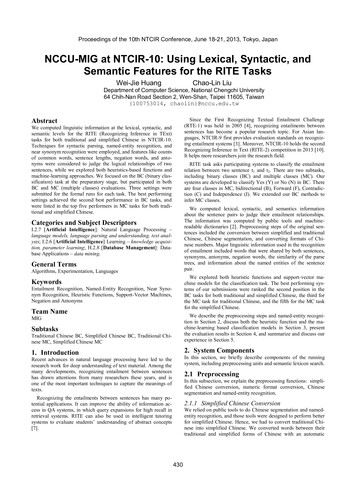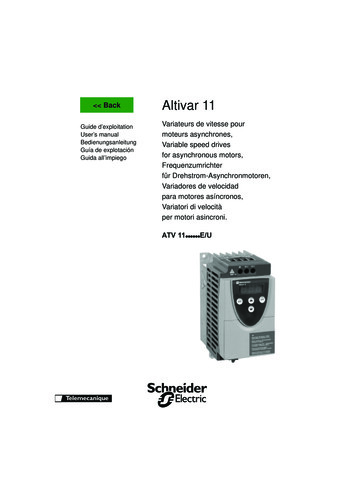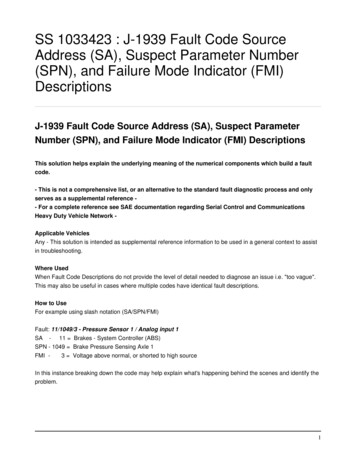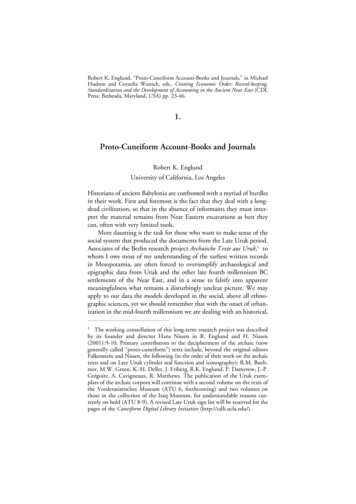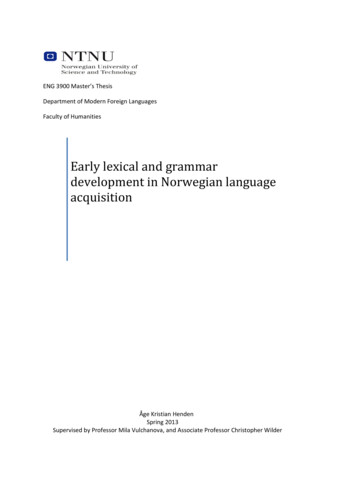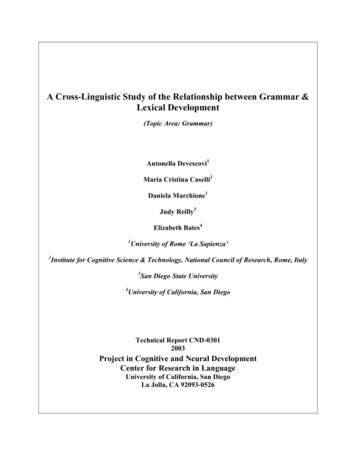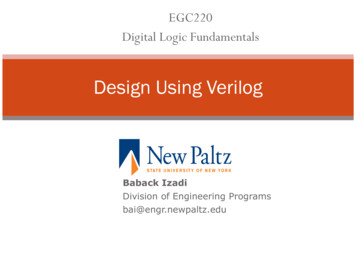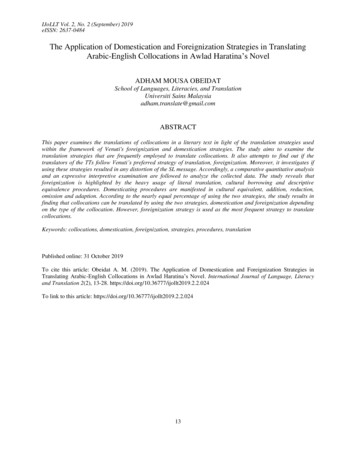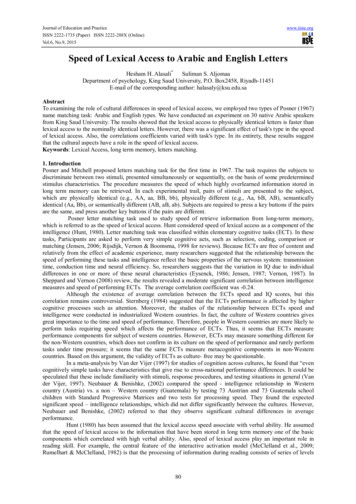
Transcription
Journal of Education and PracticeISSN 2222-1735 (Paper) ISSN 2222-288X (Online)Vol.6, No.9, 2015www.iiste.orgSpeed of Lexical Access to Arabic and English LettersHesham H. Alasali*Suliman S. AljomaaDepartment of psychology, King Saud University, P.O. Box2458, Riyadh-11451E-mail of the corresponding author: halasaly@ksu.edu.saAbstractTo examining the role of cultural differences in speed of lexical access, we employed two types of Posner (1967)name matching task: Arabic and English types. We have conducted an experiment on 30 native Arabic speakersfrom King Saud University. The results showed that the lexical access to physically identical letters is faster thanlexical access to the nominally identical letters. However, there was a significant effect of task's type in the speedof lexical access. Also, the correlations coefficients varied with task's type. In its entirety, these results suggestthat the cultural aspects have a role in the speed of lexical access.Keywords: Lexical Access, long term memory, letters matching.1. IntroductionPosner and Mitchell proposed letters matching task for the first time in 1967. The task requires the subjects todiscriminate between two stimuli, presented simultaneously or sequentially, on the basis of some predeterminedstimulus characteristics. The procedure measures the speed of which highly overlearned information stored inlong term memory can be retrieved. In each experimental trail, pairs of stimuli are presented to the subject,which are physically identical (e.g., AA, aa, BB, bb), physically different (e.g., Aa, bB, AB), semanticallyidentical (Aa, Bb), or semantically different (AB, aB, ab). Subjects are required to press a key buttons if the pairsare the same, and press another key buttons if the pairs are different.Posner letter matching task used to study speed of retrieve information from long-term memory,which is referred to as the speed of lexical access. Hunt considered speed of lexical access as a component of theintelligence (Hunt, 1980). Letter matching task was classified within elementary cognitive tasks (ECT). In thesetasks, Participants are asked to perform very simple cognitive acts, such as selection, coding, comparison ormatching (Jensen, 2006; Rijsdijk, Vernon & Boomsma, 1998 for reviews). Because ECTs are free of content andrelatively from the effect of academic experience, many researchers suggested that the relationship between thespeed of performing these tasks and intelligence reflect the basic properties of the nervous system: transmissiontime, conduction time and neural efficiency. So, researchers suggests that the variation in IQ due to individualdifferences in one or more of these neural characteristics (Eysenck, 1986; Jensen, 1987; Vernon, 1987). InSheppard and Vernon (2008) review, the results revealed a moderate significant correlation between intelligencemeasures and speed of performing ECTs. The average correlation coefficient was -0.24.Although the existence of average correlation between the ECTs speed and IQ scores, but thiscorrelation remains controversial. Sternberg (1984) suggested that the ECTs performance is affected by highercognitive processes such as attention. Moreover, the studies of the relationship between ECTs speed andintelligence were conducted in industrialized Western countries. In fact, the culture of Western countries givesgreat importance to the time and speed of performance. Therefore, people in Western countries are more likely toperform tasks requiring speed which affects the performance of ECTs. Thus, it seems that ECTs measureperformance components for subject of western countries. However, ECTs may measure something different forthe non-Western countries, which does not confirm in its culture on the speed of performance and rarely performtasks under time pressure; it seems that the same ECTs measure metacognitive components in non-Westerncountries. Based on this argument, the validity of ECTs as culture- free may be questionable.In a meta-analysis by Van der Vijer (1997) for studies of cognition across cultures, he found that “evencognitively simple tasks have characteristics that give rise to cross-national performance differences. It could bespeculated that these include familiarity with stimuli, response procedures, and testing situations in general (Vander Vijer, 1997). Neubauer & Benishke, (2002) compared the speed - intelligence relationship in Westerncountry (Austria) vs. a non – Western country (Guatemala) by testing 73 Austrian and 73 Guatemala schoolchildren with Standard Progressive Matrices and two tests for processing speed. They found the expectedsignificant speed – intelligence relationships, which did not differ significantly between the cultures. However,Neubauer and Benishke, (2002) referred to that they observe significant cultural differences in averageperformance.Hunt (1980) has been assumed that the lexical access speed associate with verbal ability. He assumedthat the speed of lexical access to the information that have been stored in long term memory one of the basiccomponents which correlated with high verbal ability. Also, speed of lexical access play an important role inreading skill. For example, the central feature of the interactive activation model (McClelland et al., 2009;Rumelhart & McClelland, 1982) is that the processing of information during reading consists of series of levels80
Journal of Education and PracticeISSN 2222-1735 (Paper) ISSN 2222-288X (Online)Vol.6, No.9, 2015www.iiste.orgcorresponding to visual features, letters and words. Other researchers have indicated that recognition of lettersand words is happening under separate processing processes (e.g., Paap et al., 1982).In fact, there is a large body of research indicates that expert readers perform faster and accuratelyduring tasks that involve letters from the known language compared to tasks that involve unfamiliar letter- likeforms (e.g., pseudoletters: Burgund, Lugar, Schlaggar, & Petersen, 2005; Burgund, Schlaggar, & Petersen, 2006;Lachmann & van Leeuwen, 2004).This means that the frequent exposure to letters of native language, and using it in everydayinteractions increasing the automaticity of processing tasks that based on it. Thus, it isn’t surprising that subjectperforming these tasks speeder than other tasks which based on unfamiliar language. These expectations linewith theories of perceptual expertise (e.g., McCandliss, Cohen, & Dehaene, 2003) and with neurological studieswhich have found that neural regions within the left occipito-temporal cortex respond preferentially to real letterscompared to non-letter forms (Cohen et al., 2000, 2002; Tagamets et al., 2000; Baker et al., 2007), andunfamiliar letters (James, et al, 2005). Other studies have suggested that the degree of left -lateralization dependson the linguistic familiarity of the characters (Appelbaum et al, 2011; Tagamets et al., 2000), the task demands(Bokde et al, 2001; Burgund et al, 2005; Ruz & Nobre, 2008), or other linguistic and developmental factors(Schlaggar & McCandliss, 2007).These finding provided evidence that performing even very simple tasks such as letter matching isaffected by culture differences, familiarity and task demands. Most of these studies have used letters andunfamiliar letter- like forms (e.g., Burgund et al, 2005; Burgund, Schlaggar, & Petersen, 2006; Lachmann & vanLeeuwen, 2004; van Leeuwen & Lachmann, 2004), but the current study used two type of Posner namematching task: English and Arabic matching letters. The experiment was conducted on university students, withnative Arabic language. They have studied English language from the beginning of the primary stage, and therestudding continued through various stages of education. Thus, if the speed of lexical access to both types ofPosner name matching tasks depends on performance components only, then there wouldn't be any differences inresponses of subjects to them.2. Method2.1 ParticipantsThirty right-handed undergraduate students from psychology department at King Saud University participated inthe experiments (mean age 20.6 - years 2.2). They volunteered to participate in the experiments. All of themare Arabic native speakers. Participants reported learning Arabic as their first language and rated Arabic as theirdominant language at the time of testing. English is the second language of the participants. Participants hadnormal or corrected-to-normal vision and no self-reported speech or hearing disorders.2.2 StimuliThe stimuli appeared on the screen of a color monitor. The background was white, while the stimuli were black.The English type of name matching task, that was used here, contains the same four letters utilized by Posnerand Mitchell (1967): A. B. C, and E in both upper-case and lower-case. Posner and Mitchell (1967) classifiedthem as: ‘physically' identical (e.g., AA), ‘nominally identical (e.g., Bb). The letters were written by 14 TimesNew Roman Bold Font.Because Arabic letters differ from the English letters we used 16 letters in the Arabic version of lettermatching task ( ي ، م ، ق ، ف ، غ ، ع ، ض ، ص ، ش ، س ، خ ، ح ، ج ، ث ، ت ، )ب . The letters were written by 14 TraditionalArabic Bold Font.The participants task were to press one key if the names of the two letters were the same (e.g., AA, Aa),and the other key if they were different (e.g., AB, aB).2.3 Apparatus and procedures.Subjects were seated in front of a 21 inch monitor and used the two Shift keys on the keyboard as responsebuttons. Tasks were counterbalanced across subjects. Half of the participants perform the Arabic version of lettermatching first and the English version of letter matching secondly. The other half of participants performs theEnglish version of letter matching first and the Arabic version of letter matching secondly. Viewing distance wasapproximately 60 cm; subject's heads were not restrained, but viewing distance was measured and adjustedbefore each set of trials.Before the session beginning, participants received instructions for the task, including which hand touse in performing responses. They were instructed to press the appropriate Shift key with the index finger. Thenthey received one block of 24 practice trials followed by 270 test trials for each task, with a brief rest period aftereach set of 90 trials.Before each trial beginning, the fixation cross appeared for 150 ms at the center of the monitor. Afterthe fixation cross disappeared, the stimuli were presented at the center of the monitor. Stimuli continue on the81
Journal of Education and PracticeISSN 2222-1735 (Paper) ISSN 2222-288X (Online)Vol.6, No.9, 2015www.iiste.orgscreen until the participant pressed response key. The computer program that generated and displayed the stimulialso recorded the keypress and response latency for each trial. Trials on which the subject responded faster than100 ms or slower than 2000 ms were scored as errors and not included in the analyses of response latencies.3. ResultsReaction times for correct responses were analyzed in a oneway, repeated-measures ANOVA with task's type(Arabic physically identical letters vs. Arabic nominally identical letters and English physically identical lettersvs. English nominally identical letters) as the independent variable. The results reveal a significant main effect ofthe task's type [F(2.040) 51.791, P 0. 0001] for reaction times. Bonferroni pairwise comparison tests showedthat the differences between Arabic physically identical letters vs. Arabic nominally identical letters, and Arabicnominally identical letters vs. English physically identical letters insignificant. However, the differences betweenother conditions were significant. Reaction times for the four conditions are shown in table 1 and in Fig.1.There was a significant difference between the two types of name matching tasks. The reaction time tothe Arabic letter matching was shorter (M 773 ms, SD 140 ms) than English letter matching (M 1091 ms,SD 244 ms), the difference was significant [T(29) 7.879, P 0. 0001].The pattern of the correlation between nominally identical letters matching and physically identicalletters matching varied with the language of the task. Although there wasn't significant correlation betweennominally identical Arabic letters matching and physically identical Arabic letters matching (r 0.17, P 0. 3),there was significant correlation between nominally identical English letters matching and physically identicalEnglish letters matching (r 0.46, P 0. 01). Also, the pattern of correlation between the two tasks varied withthe experimental condition. There wasn’t significant correlation between nominally identical Arabic lettersmatching and physically identical English letters matching (r 0.15, P 0. 4). However, There was significantcorrelation between nominally identical Arabic letters matching and nominally identical English letters matching(r 0.40, P 0. 02). On contrary, there were significant correlations between physically identical Arabic lettersmatching with physically identical English letters matching (r 0.54, P 0. 002), and with nominally identicalEnglish letters matching (r 0.41, P 0. 02).Table 1Reaction times during name matchingReaction time (ms)MeanStd. DeviationTask's typeArabic name matchingphysically identical lettersnominally identical lettersEnglish name matchingphysically identical lettersnominally identical letters7298161492138921290202328Fig. 1. Reaction times displayed as a function of task's type (Arabic physically identical letters, Arabic nominally identicalletters, English physically identical letters and English nominally identical letters).4. DiscussionPosner and Mitchell (1967) employed two forms of a visual letter matching task: physical matching and name82
Journal of Education and PracticeISSN 2222-1735 (Paper) ISSN 2222-288X (Online)Vol.6, No.9, 2015www.iiste.orgmatching. These tasks were used to study the speed of lexical access to information which stored in long termmemory. According to Jensen (1982), discrimination of a physical difference does not require access to a priorlearned semantic code, whereas discrimination of semantic differences requires access to information stored inlong term memory. So, we used name matching task to investigate possible differences within native Arabicspeakers on name matching tasks (Arabic and English). We were looking for differences since Arabic is theparticipants dominant language.The results of Posner and Mitchell (1967) showed that on name matching tasks ‘same’ responses tophysically identical letters (e.g., AA) were faster than to letters simply having the same name (e.g., Aa). Theseresults suggest that the response to physically identical letters, which must have the same name, can be basedsolely upon the initial visual codes rather than the slower forming acoustic codes required for such pairs as Aa.The results of the present study showed that reaction times for physically identical letters were faster thanreaction times for nominally identical letters in both types of name matching tasks.The differences between reaction times for physically identical letters and nominally identical letterswere very similar within both type of tasks, but there were differences in reaction times across the two types ofthe name matching tasks, which suggest that the speed of lexical access is affected by the subject's expertise andfamiliarity with tasks. These results consistent with the general pattern of previous research, which indicated thatexpert readers perform faster during tasks that involve letters from the known language compared to tasks thatinvolve unfamiliar letter- like forms (e.g., pseudoletters: Burgund, Lugar, Schlaggar, & Petersen, 2005; Burgund,Schlaggar, & Petersen, 2006; Jackson, 1980; Lachmann & van Leeuwen, 2004; van Leeuwen & Lachmann,2004), unfamiliar characters (James, 2005; Pernet, Celsis, &Dmonet, 2005).As noted above, there is no significant difference between reaction times for Arabic physicallyidentical letters and Arabic nominally identical letters. However, there is a significant difference betweenreaction times for English physically identical letters and English nominally identical letters. Thus, therelationship between the pairs of letters solely cannot explain the speed of lexical access. Accordingly, weconclude that this finding is not surprising given the subjects were native Arabic speakers, and the frequentexposure to letters that individuals in literate cultures experience daily, which make them skilled expertise inusing letters. This mean that the processes of processing information that related to Arabic letters becomeautomatic, and the response to them can be based solely upon the initial visual codes. On contrary, for nativeArabic speakers, naming the English letters require more processes and more efforts, which appear in increasingreaction times as compared to naming Arabic letters.On the other hand, the pattern of correlations between subject's reaction times varied with type ofname matching tasks. These results suggest that subjects were consistently modifying their strategies accordingto the type of matching task, and that there could be a common underlying process mediating the performance ofsubjects on the type of matching task. Therefore, for native Arabic speakers, naming Arabic letters may be basedon performance components, while naming English letters may be based on metacognitive components.In conclusion, results from the present study indicate that the speed of naming letters varied with thetype of matching task. Thus, the speed of lexical access does not necessarily emerge as a consequence ofrelationship between the letters pairs. The results entirely reflect the possibility that the processes underlyingperforming ECTs are affected by some aspects of culture. Therefore, the validity of ECTs as culture- free may bequestionable.ReferencesAppelbaum, L.G.1., Smith, D.V., Boehler, C.N., Chen, W.D., & Woldorff, M.G. (2011). Rapid Modulation ofSensory Processing Induced by Stimulus Conflict. Journal of Cognitive Neuroscience, 23, 2620–2628.Baker C. I., Liu J., Wald L. L., Kwong K. K., Benner T., Kanwisher N. (2007). Visual word processing andexperiential origins of functional selectivity in human extrastriate cortex. Proc. Natl. Acad. Sci.U.S.A. 104, 9087–909210.1073/pnas.0703300104 [PMC free article][PubMed] [Cross Ref].Bokde, A.L.W., Tagaments, M.-A., Friedman, R.B., & Horwitz, B. coil. (2001). Functional interactions of theinferior frontal cortex during the processing of words and word-like stimuli. Neuron, 30, 609–617.Burgund, E. D., Lugar, H. M., Schlaggar, B. L., & Petersen, S. E. (2005). Task demands modulate sustained andtransient neural activity during visual matching tasks. NeuroImage, 25, 511–519.Burgund, E. D., Schlaggar, B. L., & Petersen, S. E. (2006). Development of letter specific processing: The effectof reading ability. Acta Psychologica, 122, 99– 08.Burgund, E.d., & Abernathy, E.A. (2008). Letter-specific processing in children and adults matched for readinglevel. Acta Psychologica, 129 , 66–71.Cardoso-Martins, C., Rodrigues, L. A., & Ehri, L. C. (2003). Place of environmental print in readingdevelopment: Evidence from nonliterate adults. Scientific Studies of Reading, 7, 335–355.Cohen L., Lehericy S., Chochon F., Lemer C., Rivaud S., Dehaene S. (2002). Language-specific tuning of visualcortex? Functional properties of the Visual Word Form Area. Brain, 125, 1054–83
Journal of Education and PracticeISSN 2222-1735 (Paper) ISSN 2222-288X (Online)Vol.6, No.9, 2015www.iiste.org106910.1093/brain/awf094[PubMed] [Cross Ref]Cohen, L., Dehaene, S., Naccache, L., Lehéricy, S., Dehaene-Lambertz, G., Henaff, M. A., et al. (2000). Thevisual word form area: Spatial and temporal characterization of an initial stage of reading in normalsubjects and posterior split-brain patients. Brain, 123, 291–307.Eysenck, H.J. (1986). Intelligence: The new look. Psychologische Beiträge, 28, 332-365.Greenberg, D., Ehri, L. C., & Perin, D. (1997). Are word-reading processes the same or different in adult literacystudents and third-fifth graders matched for reading level? Journal of Educational Psychology, 89,262–275.Greenberg, D., Ehri, L. C., & Perin, D. (2002). Do adult literacy students make the same word-reading andspelling errors as children matched for word-reading age? Scientific Studies of Reading, 6, 221–243.Hunt, E. (1980). Intelligence as an information processing concept. British Journal of Psychology, 71, 449-474.Jackson, M. D. (1980). Further evidence for a relationship between memory access and reading ability. Journalof Verbal Learning and Verbal Behavior, 19, 683– 694.James, K. H., James, T. W., Jobard, G., Wong, A. C. N., & Gauthier, I. (2005). Letter processing in the visualsystem: Different activation patterns for single letters and strings. Cognitive, Affective, and BehavioralNeuroscience, 5, 452–456.Jensen A. R. (1982) Reaction time and psychometric g. In A model of intelligence. (Edited by Eysenck H. J.). pp.93-133. Springer, New York.Jensen, A. R. (1987). The g beyond factor analysis. In R. R. Ronning, J. A. Glover, J. C. Conoley, and J. C. Witt(Eds.), The influence of cognitive psychology on testing. Hillsdale, NJ: Erlbaum. pp. 87—142.Jensen, A. R. (2006). Clocking the mind: Mental chronometry and individual differences. Oxford: Elsevier.Lachmann, T., & van Leeuwen, C. (2004). Negative congruence effects in letter and pseudo-letter recognition:The role of similarity and response conflict. Cognitive Processing, 5, 239–248.McCandliss, B. D., Cohen, L., & Dehaene, S. (2003). The visual word form area: Expertise for reading in thefusiform gyrus. Trends in Cognitive Science, 7, 293–299.McClelland, J. L., Rogers, T. T., Patterson, K., Dilkina, K. N., & Lambon Ralph, M. R. (2009). SemanticCognition: Its Nature, Its Development, and its Neural Basis. In M. Gazzaniga (Ed.), The CognitiveNeurosciences IV. Boston, MA: MIT Press.Neubauer, A.C. & Benischke, C. (2002). A cross-cultural comparison of the relationship between intelligenceand speed of information processing in Austria vs. Guatemala. Psychologische Beiträge, 44, 521-534.Paap, K. R., Newsome, S. L., McDonald, J. E., & Schvaneveldt, R. W. (1982). An activation-verification modelfor letter and word recognition. Psychological Review, 89, 573–594.Pernet, C., Celsis, P., & Démonet, J. F. (2005). Selective response to letter categorization within the left fusiformgyrus. NeuroImage, 28, 738–744.Posner, M. J., & Mitchell, R. F. (1967). Chronometric analysis of classification. Psychological Review, 74, 392–409.Rijsdijk, F.V., Vernon, P.A., & Boomsma, D.I. (1998). The genetic basis of the relation between speed-ofinformation-processing and IQ. Behavioural Brain Research, 95(1), 77-84.Rumelhart, D. E. & McClelland, J. L. (1982). An interactive activation model of context effects in letterperception: Part 2. The context enhancement effect and some tests and extensions of the model.Psychological Review, 89, 60-94.Ruz, M.,& Nobre, A.C. (2008). Attention modulates initial stages of word processing. Journal of CognitiveNeuroscience, 20 (9), 1727-1736.Schlaggar, B.L., McCandliss, B.D. (2007) Development of neural systems for reading. Annual Reviews ofNeuroscience, 30:475-503.Sheppard, L.D. & Vernon, P.A. (2008). Intelligence and speed of information-processing: A review of 50 yearsof research. Personality and Individual Differences, 44, 535–551.Sternberg, R. J. (1984). Toward a triarchic theory of human intelligence. Behavioral and Brain Sciences, 7, 269287.Tagamets, M. A., Novick, J. M., Chalmers, M. L., Friedman, R. B. (2000). A parametric approach toorthographic processing in the brain: an fMRI study. Journal of Cognitive Neuroscience, 12, 281–297.Thompkins, A. C., & Binder, K. S. (2003). A comparison of the factors affecting reading performance offunctionally illiterate adults and children matched by reading level. Reading Research Quarterly, 38,236–258.van de Vijver, F. J. R. (1997). Meta-analysis of cross-cultural comparisons of cognitive test performance.Journal of Cross-Cultural Psychology, 28, 678-709.van Leeuwen, C., & Lachmann, T. (2004). Negative and positive congruence effects in letters and shapes.Perception & Psychophysics, 66, 908–925.Vernon, P. E. (1987). Speed of information processing and intelligence. Norwood, NJ: Ablex.84
The IISTE is a pioneer in the Open-Access hosting service and academic event management.The aim of the firm is Accelerating Global Knowledge Sharing.More information about the firm can be found on the homepage:http://www.iiste.orgCALL FOR JOURNAL PAPERSThere are more than 30 peer-reviewed academic journals hosted under the hosting platform.Prospective authors of journals can find the submission instruction on the followingpage: http://www.iiste.org/journals/ All the journals articles are available online to thereaders all over the world without financial, legal, or technical barriers other than thoseinseparable from gaining access to the internet itself. Paper version of the journals is alsoavailable upon request of readers and authors.MORE RESOURCESBook publication information: http://www.iiste.org/book/Academic conference: es-call-for-paper/IISTE Knowledge Sharing PartnersEBSCO, Index Copernicus, Ulrich's Periodicals Directory, JournalTOCS, PKP OpenArchives Harvester, Bielefeld Academic Search Engine, Elektronische ZeitschriftenbibliothekEZB, Open J-Gate, OCLC WorldCat, Universe Digtial Library , NewJour, Google Scholar
Journal of Education and Practice www.iiste.org ISSN 2222-1735 (Paper) ISSN 2222-288X (Online) Vol.6, No.9, 2015 81 corresponding to visual features, letters and words. Other researchers have indicated that recognition of letters . Because Arabic letters differ from the English letters we used 16 letters in the Arabic version of letter
